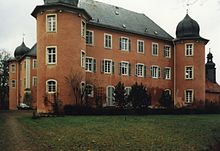Waltershausen murder case

On Wednesday, 30 November 1932 were in the castle of Waltershausen in grave field captain a lord of the castle. D. Waldemar Werther , shot and his wife Wilhelmine (née von Feilitzsch ) shot. The crime, which has not yet been fully clarified, led to a sensational process that was exploited by the National Socialists for propaganda purposes.
did
On the morning of November 30, shortly after 8 o'clock, the lady of the castle is said to have come into a neighboring house covered in blood and shouted: “My husband was shot and I was shot! Karl! Karl, I saw him and spoke to him! ” The aforementioned“ Karl ”was the gardener and chauffeur Karl Liebig, whom the Werther couple had given notice shortly before due to financial difficulties.
Wilhelmine Werther had gunshot wounds in his hand and shoulder and a graze in the face. Her husband was found dead in bed with multiple gunshot wounds.
Investigations
According to statements from neighbors, shots are said to have risen in the castle around 2 a.m. Wilhelmine Werther testified that Karl Liebig broke into her room and that of her husband during the night and shot them. She then opened a window and fired three more shots to drive away the perpetrator and call for help. Waldemar Werther's death occurred around five in the morning.
Investigations revealed that Werther was killed by a shot from his own pistol, while his wife's gunshot wounds were from an unknown weapon.
Domestic worker Karl Liebig was arrested after a gun was found in his room that had been shot shortly before. However, Liebig claimed that he shot a bird of prey.
Due to the unclear investigation, Karl Liebig was released from pre-trial detention after a while and Ms. Werther was temporarily detained. In the end, however, charges were brought against Liebig.
process
The trial began on April 4, 1934 before the Schweinfurt jury court . For public defender Karl Liebig was Peter Deeg been ordered, a young lawyer and Nazi -member. Liebig himself had been a party member since 1929 and also a member of the SA . The legal representation of Wilhelmine Werther took over the respected Schweinfurt lawyer Moses Hommel. The case files are considered lost.
The process developed into a politically charged propaganda confrontation. With the help of witnesses from the National Socialist environment, Deeg portrayed Liebig as a thoroughly honest German worker, convinced National Socialist and decent SA man in line with the Nazi ideology were. The Werther couple, who were nationally -minded in Germany, also had sympathy for National Socialism, but in contrast to Liebig, they were extremely unpopular with the local population. In addition, the formerly very wealthy family was in extreme financial need at the time of the crime as a result of inflation , the global economic crisis and mismanagement. Deeg's strategy was supported by the National Socialist regional press. After a former chauffeur and Wilhelmine Werther's son from his first marriage, Baron von Waltershausen, were also named as other suspects, Karl Liebig was finally acquitted for lack of evidence. The prosecution had requested manslaughter and attempted manslaughter for 15 years.
Moses Hommel appears to have emigrated to Haifa in 1934 as a result of the propaganda surrounding the trial . In 1949 a booklet was published with the title “Licht im Schloß” , the plot of which is closely related to the events in Waltershausen.
literature
(in chronological order)
- Franconian daily newspaper from April 5, 1934 - April 27, 1934.
- The riddle of Waltershausen 1932–1934. In: Paul Wiegler : Fates and Crimes. The great trials of the last hundred years. Ullstein, Berlin 1935, pp. 330–342.
- Albert Brodbeck: Light in the castle. (= The novel narrator 4). Volker-Verlag, Cologne 1949.
- Reinhard Weber: The fate of the Jewish lawyers in Bavaria after 1933. Oldenbourg, Munich 2006, ISBN 3-486-58060-4 .
- Ingrid Heeg-Engelhart: Estate of Dr. iur. utr. Peter Deeg (1908–2005) handed over to the State Archives in Würzburg. In: News from the state archives of Bavaria. No. 53, July 2007, ISSN 0721-9733 , p. 24.
- Gerhard Fischer: The Nazis and a scandalous trial. In: Main-Post , July 1, 2011. ( online preview)
- Martin Arnegger: The Werthers. The Waltershausen murder case. Pressel, Remshalden 2011, ISBN 978-3-937950-99-0 .
Web links
- Peter Ziegler: Relationship drama or act of revenge in the castle? ( Memento of March 2, 2013 in the Internet Archive ). In: Waltershausen-Grabfeld.de
- The murder case of Waltershausen Castle - video report by TV Mainfranken , December 18, 2017 (11:59 min.)
Individual evidence
- ↑ Ingrid Heeg-Engelhart: “Estate of Dr. iur. utr. Peter Deeg (1908–2005) handed over to the Würzburg State Archives ”, in: News from the Bavarian State Archives . No. 53, July 2007, ISSN 0721-9733 , p. 24.
- ↑ Reinhard Weber: The fate of Jewish lawyers in Bavaria after 1933. Oldenbourg, Munich 2006, ISBN 3-486-58060-4 , p. 171.
Coordinates: 50 ° 20 ′ 19 ″ N , 10 ° 23 ′ 3 ″ E
